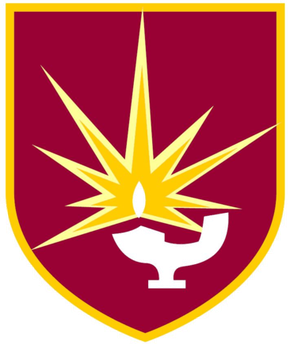
Tunbridge Wells Grammar School for Boys (TWGSB) is a grammar school in Royal Tunbridge Wells, Kent, England.
Sir William Borlase's Grammar School is a selective state grammar school accepting girls and boys aged 11–18 located in Marlow, Buckinghamshire, England. It is situated on West Street, close to the town centre and also accepts students from nearby towns. It has around 1000 pupils, including a sixth form of about 380.

The Skinners' School, is a British Grammar School with academy status for boys located in the town of Royal Tunbridge Wells, Kent, England. Established in 1887, the school was founded by the Worshipful Company of Skinners in response to a demand for education in the region. Today Skinners' remains an all-boys grammar school, recently awarded specialist status in science and mathematics in recognition of these disciplines' excellent teaching. The current enrolment is 1119 pupils, of whom around 326 are in the sixth form. The first headmaster was Reverend Frederick Knott, after whom Knott House is named. The current Headmaster is Edward Wesson.

Clitheroe Royal Grammar School is a co-educational grammar school in the town of Clitheroe in Lancashire, England, formerly an all-boys school. It was founded in 1554 as "The Free Grammar School of King Philip and Queen Mary" "for the education, instruction and learning of boys and young men in grammar; to be and to continue for ever."

Poole Grammar School is an 11–18 selective boys grammar school and academy in the coastal town of Poole in Dorset, on the south coast of England. It is a member of the South West Academic Trust (SWAT). The school was a mathematics and computing school, with an additional specialism, cognition, added in 2006.
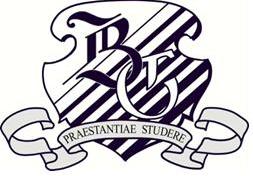
Bexley Grammar School is a co-educational grammar school with academy status in Welling, in the London Borough of Bexley, UK. It takes boys and girls aged 11–18 who have passed the eleven plus exam.

Dartford Grammar School for Girls is a grammar school for girls in Dartford, Kent, England. Formerly known as Dartford County School, the school opened in 1904. It is the sister school of Dartford Grammar School for Boys.

Queen Elizabeth's High School is a mixed grammar school in Gainsborough, Lincolnshire, England. The school, established in 1983, but with a timeline to 1589, is an amalgamation of the previous Gainsborough High School and Queen Elizabeth's Grammar School.

Carre's Grammar School is a selective secondary school for boys in Sleaford, a market town in Lincolnshire, England.
Oxted School is a coeducational secondary school and sixth form located in the English town of Oxted, Surrey. It was opened in 1929 as the first mixed grammar school in Surrey and now has over 1,900 pupils aged 11–18.
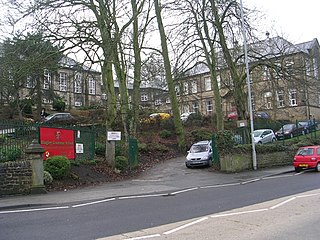
Bingley Grammar School (BGS) is a Voluntary aided school for students from the ages of 11–18 and is located on the outskirts of Bingley, West Yorkshire, England.

Rochester Grammar School often abbreviated to RGS is a grammar school for the education of girls between the ages of 11 and 18. It has academy status. It is now known as just "Rochester Grammar School" following the introduction of boys into the sixth form, despite the rest of the school remaining single sex.
The Harvey Grammar School is located in Folkestone, Kent, England. It is a grammar school with academy status founded by the family of William Harvey in 1674.

Saint Marylebone School is a secondary school for girls in Marylebone, London. It specialises in Performing Arts, General Arts, Maths & Computing. In the sixth form, boys can attend as well. The school then became a converter academy, having previously been judged as "outstanding in every respect" by Ofsted.

Wallingford School is a secondary school with academy status located in the town of Wallingford, Oxfordshire, England. It was founded by Walter Bigg in 1659 in association with the Worshipful Company of Merchant Taylors, formally succeeding Wallingford Grammar School when it merged with Blackstone Secondary Modern in 1973.
Finchley Catholic High School is a boys' secondary school with a coeducational sixth form in North Finchley, part of the London Borough of Barnet, England. The current head teacher is Niamh Arnull, who had previously been a member of the teaching staff in the 1990s.

Skinners' Academy is a school in the Manor House area for boys and girls aged 11–19. The academy opened in 2010 and is supported by the Worshipful Company of Skinners, a London Livery Company. There are currently approximately 900 pupils on roll from Year 7 - Year 11 and over 100 Sixth Form students. More than 60% of the pupils speak English as an additional language and more than 86% of students are from ethnic minority backgrounds.
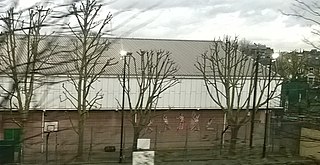
Chestnut Grove Academy is an 11–19 mixed partially selective secondary school with academy and Visual Arts College status in Balham, London, England. In January 2019, Chestnut Grove was assessed in an OFSTED inspection report as good.
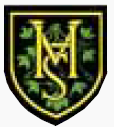
Valentines High School is a coeducational secondary school and sixth form located in the Ilford area of the London Borough of Redbridge, England. It has approximately 1300 pupils and 93 teachers. Valentines has been a teaching school since 2011, and is a member of the Leading Edge partnership programme. In 2006, it was designated as a specialist school for technology and had technology college status.
Cumberland Community School is a coeducational secondary school located in the London Borough of Newham, England. Every year-group consist of 300 pupils with 10 classes of 30 pupils each. It is situated on Oban Close off Prince Regent Lane close to its junction with Newham Way and has substantial land, sharing facilities with neighbouring Newham Leisure Centre. It is built on the site of the former Woodside Community School.














